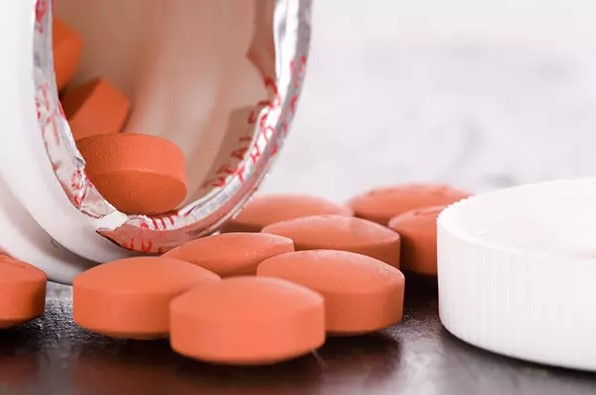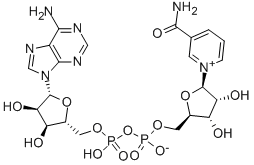NAD+:Introduction;Biosynthesis;Metabolism in aging and disease
Nov 16,2023
Introduction
NAD+ is a coenzyme consisting of ribosyl nicotinamide 5'-diphosphate coupled to adenosine 5'-phosphate via a pyrophosphate bond. The first identified function of nicotinamide adenine dinucleotide (NAD+) was its ability to reversibly bind hydride ions, which are formally defined as anions of hydrogen (H−).
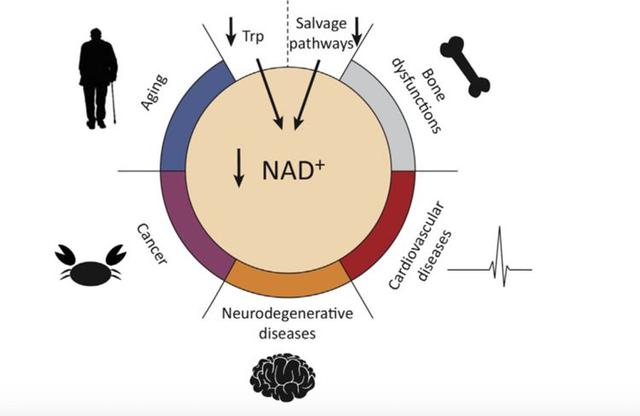
This chemical property is known to play a crucial role in cellular metabolism, where NAD+serves as an electron acceptor in oxidation–reduction (redox) reactions during the breakdown of energetic substrates (e.g, glucose, fatty acids), thus generating NADH as reducing equivalent. Apart from these fundamental redox properties, numerous further processes crucial for cell vitality are dependent on NAD+. For instance, NAD+serves as a substrate for NAD+-consuming enzymes, such as sirtuins (SIRTs), poly(ADP-ribose) polymerases (PARPs), and ectoenzymes like cluster of differentiation (CD)38, CD157, or the recently discovered sterile alpha and toll interleukin receptor motif-containing protein 1 (SARM1). Despite the apparent structural resemblance, NADP+, the phosphorylated form of NAD+, has rather distinct functions in cellular metabolism. NADP+ is reduced to NADPH in the pentose phosphate pathway and serves as a redox partner in the reductive biosynthesis of fatty acids, cholesterol, and steroid hormones, hepatic detoxification of xenobiotics, and oxidative defenses.
NAD+ Biosynthesis
NAD+ biosynthesis can broadly be divided into the kynurenine pathway, the Preiss-Handler pathway, and a salvage pathway. While these pathways all generate NAD+ from different nutritional precursors, the salvage pathway additionally recycles NAD+ from nicotinamide—a cleavage product arising from the activity of NAD+-consuming enzymes(Figure 1).
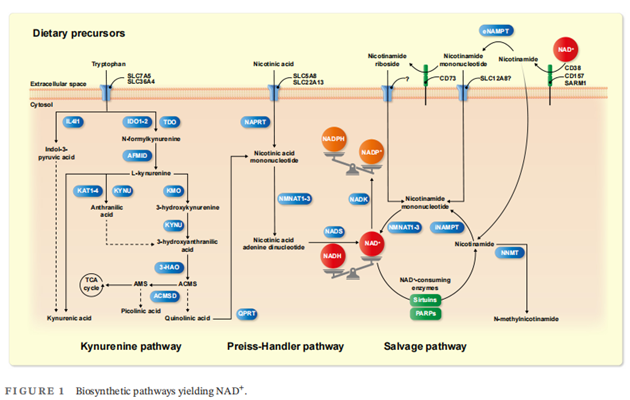
Intracellular levels of NAD+ are held constant via three distinct pathways using the dietary precursors tryptophan, nicotinic acid, nicotinamide riboside, nicotinamide mononucleotide, and nicotinamide. The kynurenine pathway depicts the major catabolic route of the essential amino acid tryptophan, generating quinolinic acid (QA) as one of its end products. QA then converges with the PreissHandler pathway, ultimately yielding NAD+. The salvage pathway either recycles NAD+ from nicotinamide after it has been cleaved by NAD+-consuming enzymes or incorporates dietary precursors. Note, that the illustration above serves as a schematic overview of NAD+- synthesizing pathways. For tissue-specific and subcellular expression patterns of the corresponding enzymes please refer to Ref. 15. 3-HAO, 3-Hydroxyanthranilate 3,4-dioxygenase; ACMS, α-amino-β-carboxymuconate ε-semialdehyde; ACMSD, aminocarboxymuconate semialdehyde decarboxylase; AFMID, arylformamidase; AMS, 2-aminomuconic-6-semialdehyde; IDO, indolamine 2,3-dioxygenase; IL4I1, interleukin 4 induced 1; iNAMPT and eNAMPT, intracellular and extracellular nicotinamide phosphoribosyltransferase; KAT, kynurenine aminotransferase; KMO, kynurenin-3-monooxygenase; KYNU, kynureninase; NADK, NAD kinase; NADS, NAD synthase; NAPRT, nicotinate phosphoribosyltransferase; NMNAT, nicotinamide mononucleotide adenylyltransferase; NNMT, nicotinamide N-methyltransferase; NRK, nicotinamide riboside kinase; PARPs, poly(ADP-ribose) polymerases; QPRT, quinolinate phosphoribosyltransferase; SARM1, sterile alpha and toll interleukin receptor motif–containing protein 1; SLC, solute carrier; TCA, tricarboxylic acid; TDO, tryptophan 2,3-dioxygenase.
NAD+ metabolism in aging and disease
Over the last decades alterations in NAD+ metabolism have been revealed in multiple age-associated diseases, including neoplastic, metabolic, and neurodegenerative diseases, as well as aging per se. Depending on the investigated population (rodents vs. humans) and tissue type, the NAD+ levels of aged subjects were reported to range from 15% to 90% of normal tissue levels. Current hypotheses for this age-dependent decline revolve around the frequently formulated “hallmarks of ageing”, including loss of proteostasis and genomic stability.
NAD+ biosynthesis enzymes become dysfunctional during aging, resulting in decreased NAD+ levels. Additionally, the age-associated accumulation of DNA damage is thought to increase PARP activity, reinforcing the cellular decline of NAD+. 29 This renders NAD+-dependent processes such as energy metabolism and DNA repair ineffective, leading to age-related pathophysiology and tissue degeneration. Despite overall claims of NAD+ decline with age the scientific evidence is rather limited and often restricted to certain tissue types.
References:
[1] DAVID WALZIK. Tissue-specific effects of exercise as NAD+-boosting strategy: Current knowledge and future perspectives[J]. Acta Physiologica, 2023, 237 3. DOI:10.1111/apha.13921.
- Related articles
- Related Qustion
- Oxidation and reduction of β-Nicotinamide adenine dinucleotide (NAD+) Jun 7, 2024
β-Nicotinamide adenine dinucleotide (NAD+) is an electron carrier as it carries electrons from hydride from one region of the cell to another.
- Side effects of NAD+ oral or injectable therapy Apr 17, 2024
NAD+ is present in every cell in the body, and is essential for the production of cellular energy and the maintenance of cellular health.
- β-Nicotinamide adenine dinucleotide: Biosynthesis, physiological function and application Apr 17, 2023
β-Nicotinamide adenine dinucleotide is a cofactor and plays a major role in metabolism, involved in redox reactions, carrying electrons from one reaction to another.
Ibuprofen is the most commonly used and prescribed NSAID. It is a common over-the-counter medication widely used as an analgesic, anti-inflammatory, and antipyretic.....
Nov 16,2023APIFormaldehyde is classified by the International Agency for Research on Cancer as carcinogenic.....
Nov 16,2023Organic reagentsYou may like
β-Nicotinamide adenine dinucleotide manufacturers
- NAD
-
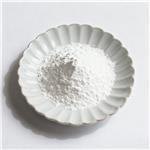
- $0.00 / 1box
- 2025-12-14
- CAS:53-84-9
- Min. Order: 1box
- Purity: 0.99
- Supply Ability: 10tons
- NAD+ 99.9% Purity American Warehouse Cosmetic Peptide
-
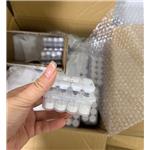
- $50.00 / 1Box
- 2025-12-14
- CAS:53-84-9
- Min. Order: 1Box
- Purity: 99%
- Supply Ability: 10000
- Nicotinamide Adenine Dinucleotide(NAD?)
-

- $1.00 / 5KG
- 2025-12-14
- CAS:53-84-9
- Min. Order: 25KG
- Purity: 99%
- Supply Ability: 20T




